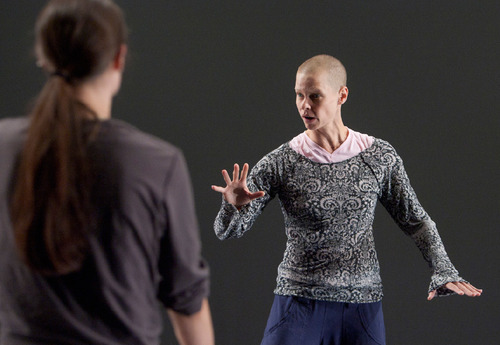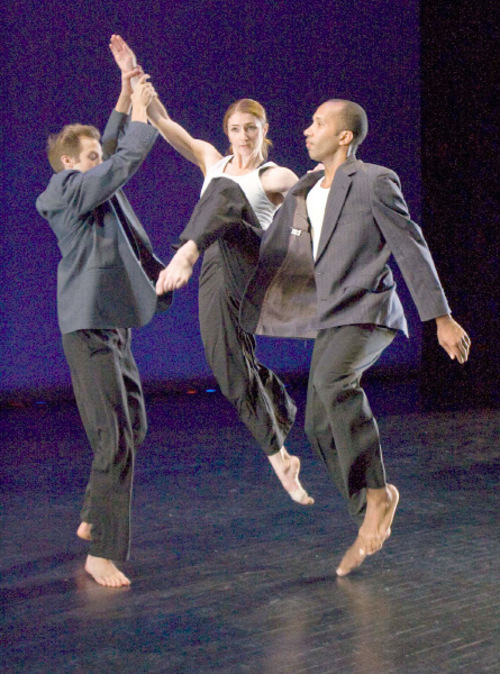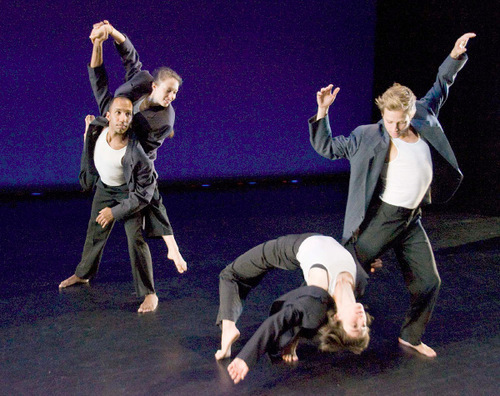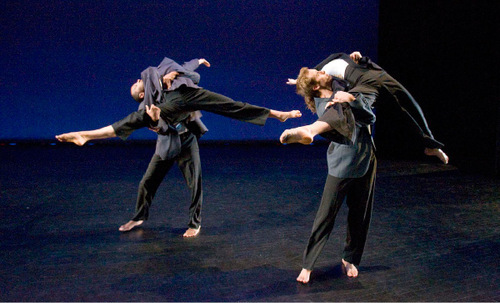This is an archived article that was published on sltrib.com in 2010, and information in the article may be outdated. It is provided only for personal research purposes and may not be reprinted.
Although Charlotte Boye-Christensen's "32 Short Films About Glenn Gould" is the only premiere on the company's upcoming performance, the reworking of David Rousseve's "Bittersweet Chocolate" and the fresh staging of Bill T. Jones' "Duet" just might make it hard to decipher which dance you haven't seen before.
And the intricacies of Susan Marshall's "Cloudless," performed by the company last year, make it fair game for a second viewing.
Last summer, when Leah Cox came to town to set Jones' 2005 piece "Duet" on R-W dancers, she also set the arts community on fire. Cox, who danced with Bill T. Jones' company for eight years, is a magnificent mover, with a classical dancer's body, limpid blues eyes and a shaved head. And if her physical presence weren't enough, there was also her articulate descriptions of Jones' passion for dance as a vehicle for social change.
"Bill's process is about creating dancers who are independent thinkers — people who will go out and change the world through movement," Cox said.
Even in casual conversation, Cox accentuates each word with movement, as if her life really has become a dance. While watching her move, it's easy to visualize the strength in her belief that the process of social change can happen through art.
"Being aware will make you curious, which will move you to ask a question, which will move you to ask the next question," Cox said. "And once you've answered the question, you'll want to tell someone else. And that is how I address social change through dance education. You have to be aware, and you have to be curious."
Since Jones' work is known for its socio-political content, Cox says the detail and sophistication of the actual movement sometimes go unnoticed.
She praised the dance company's decision to revive Jones' 1995 piece, which she described as "pure, task-based movement." " 'Duet' allows people to see the nuance and beauty of his work."
Reaching into its own past, R-W also will restage a 1996 work by L.A. choreographer David Rousseve, "Bittersweet Chocolate." Rousseve returned to Salt Lake City 15 years later, to work with only one dancer from R-W's 1996 company — Juan Carlos Claudio, a guest artist for this piece.
Claudio earned an MFA in modern dance from the University of Utah, where he's currently an assistant professor/lecturer. He was a R-W company member from 1996-2006 and has also danced with the Utah-based SB Dance and in works by Stephen Koester.
In rehearsal, Rousseve said he and Claudio developed "a synergy where he would remember the essence of the movement, and provide an image that could instantly bring us back to the intention of 15 years ago."
Fine-tuning a dance is a luxury, and Rousseve said he enjoyed tweaking such elements as the structure, transitions and subtle choreographic changes.
"The piece is very physical, yet it shouldn't be danced too muscularly, because there is a vulnerability at the heart of the piece that needs to come out," he said, referring to the emotional themes of the dance, which considers the contradiction between the beauty and difficulty of love.
A spoken text weaves through "Bittersweet Chocolate," providing a balance between the directness of theater and the subtext of poetry of movement. The voiceover is read by an older, Southern African American woman. Rousseve grew up with a strong father, but said he learned important life lessons at the knee of his mother, grandmother and other older women in his home and community.
"In their own way, through phrases and sayings, they passed on their philosophy and wisdom about how to be in the world," Rousseve said.
Rousseve noted the "amazing versatility" required of contemporary dancers."The good and the bad of television dance is that dance is more present than ever in today's world, and these kids have grown up seeing lots of interdisciplinary work," Rousseve said. "So if I say 'In this piece, we have some old-school modern, a little of that release work, some jazzy movement, and we'll throw in some dramatic text,' they're like 'OK, we get that.' "
Fitting that description are R-W's two new dancers, Barbi Powers and Tara McArthur, who arrived last month to a trial by fire in learning artistic director Boye-Christensen's very complicated movement style. The company is also welcoming back dancer Jo Blake after a one-year hiatus.
Boye-Christensen's new piece, "32 Short Films About Glenn Gould," is a metaphorical biography about one of the most celebrated pianists of the 20th century, who died at age 49 in 1982. He was known for his eccentricities, ranging from his belief that he related to animals better than humans to his unusual mannerisms at the keyboard.
Boye-Christensen is intrigued by Gould's technical skill and ability to infuse a personal relevance into music. But what captivated her further was Gould's decision to stop performing at age 31, in favor of studio recording and educational projects.
"The artist's responsibility to his/her audience is a significant part of any performer's life," Boye-Christensen said. "And that he made a specific decision to give that up at such a young age fascinates me."
The piece is divided into five short segments, each revealing a different part of Gould's emotional story. The dance is at once energetic, physical and weighted — the same three things that made Boye-Christensen fall in love with Gould's music: "his willingness to be absurd, playful and naïve." —
Go (con)figure
P Ririe-Woodbury presents "Configurations."
When • Thursday-Saturday, Sept. 23-25, at 7:30 p.m.
Where • Rose Wagner Performing Arts Center's Jeanné Wagner Theatre, 138 W. 300 South, Salt Lake City
Tickets • $30 ($15 students/seniors), at 801-355-2787 or http://www.arttix.org
Running Time • Two hours











